Physical Address
304 North Cardinal St.
Dorchester Center, MA 02124
Children are not merely little adults, and their diseases are not merely variants of adult diseases. Many childhood conditions are unique to, or at least take distinctive forms in, this stage of life and so are discussed separately in this chapter. Diseases originating in the perinatal period are important in that they account for significant morbidity and mortality. The chances for survival of infants improve with each passing week. The infant mortality rate in the United States has shown a decline from a level of 20 deaths per 1000 live births in 1970 to 5.8 in 2014. Although the death rate has continued to decline for all infants, African Americans continue to have an infant mortality rate more than twice (11 deaths per 1000 live births) that of American whites (4.9 deaths). Worldwide, infant mortality rates vary widely, from as low as 1.8 deaths per 1000 live births in Slovenia, to as high as 110.6 deaths in Afghanistan. Rather dismayingly, the United States ranks thirtieth in infant mortality rate among high income nations in the Western hemisphere.
Each stage of development of the infant and child is prey to a somewhat different group of disorders: (1) the neonatal period (the first 4 weeks of life), (2) infancy (the first year of life), (3) 1 to 4 years of age, and (4) 5 to 14 years of age.
Congenital anomalies, prematurity and low birth weight, sudden infant death syndrome, and maternal complications and injuries represent the leading causes of death in the first 12 months of life. Once the infant survives the first year of life, the outlook brightens measurably. In the next two age groups—1 to 4 years and 5 to 9 years—unintentional injuries resulting from accidents are the leading cause of death. Among the natural diseases, in order of importance, congenital anomalies and malignant neoplasms assume major significance. In the 10- to 14-year age group, accidents, malignancies, suicide, homicide, and congenital malformations are the leading causes of death.
The following discussion looks at specific conditions encountered during the various stages of infant and child development.
Congenital anomalies are anatomic defects that are present at birth, but some, such as cardiac defects and renal anomalies, may not become clinically apparent until years later. The term congenital means “born with,” but it does not imply or exclude a genetic basis for the birth defect. It is estimated that about 120,000 (1 in 33) babies are born with a birth defect each year in the United States. In a sense, anomalies found in live-born infants represent the less serious developmental failures in embryogenesis as they are compatible with live birth. Perhaps 20% of fertilized ova are so anomalous that they are blighted at early stages. Others may be compatible with early fetal development, only to lead to spontaneous abortion. Less severe anomalies allow more prolonged intrauterine survival, with some disorders terminating in stillbirth and those still less significant permitting live birth despite the handicaps imposed.
The process of morphogenesis (organ and tissue development) can be impaired by a variety of different errors.
Malformations represent primary errors of morphogenesis , in which there is an intrinsically abnormal developmental process ( Fig. 10.1 ). Malformations can be the result of a single gene or chromosomal defect, but are more commonly multifactorial in origin. Developmental anomalies may present in several patterns. Some, such as congenital heart defects and anencephaly (absence of part or all of the brain), involve single body systems, whereas in other cases multiple malformations involving many organs may coexist.
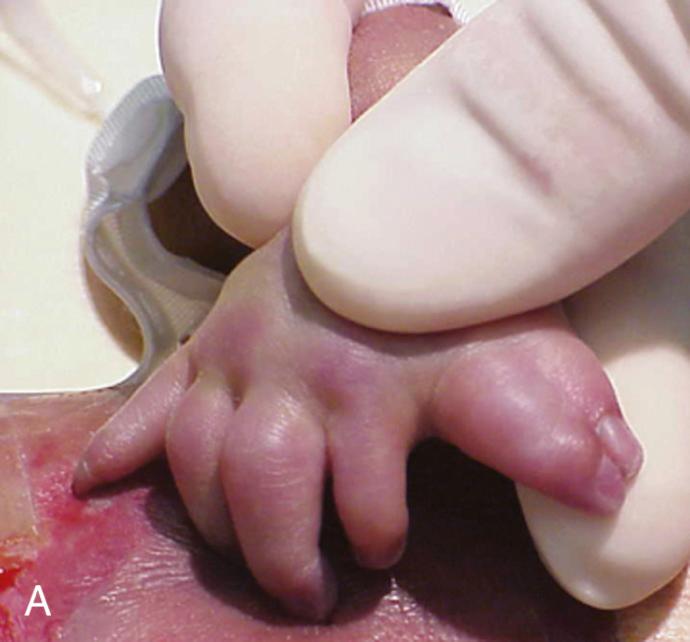
Disruptions result from secondary destruction of an organ or body region that was previously normal in development ; thus, in contrast with malformations, disruptions arise from an extrinsic disturbance in morphogenesis. Amniotic bands, denoting rupture of amnion with resultant formation of “bands” that encircle, compress, or attach to parts of the developing fetus, are the classic example of a disruption ( Fig. 10.2 ). A variety of environmental agents may cause disruptions (see later). Disruptions are not heritable, hence they are not associated with increased risk of recurrence in subsequent pregnancies.
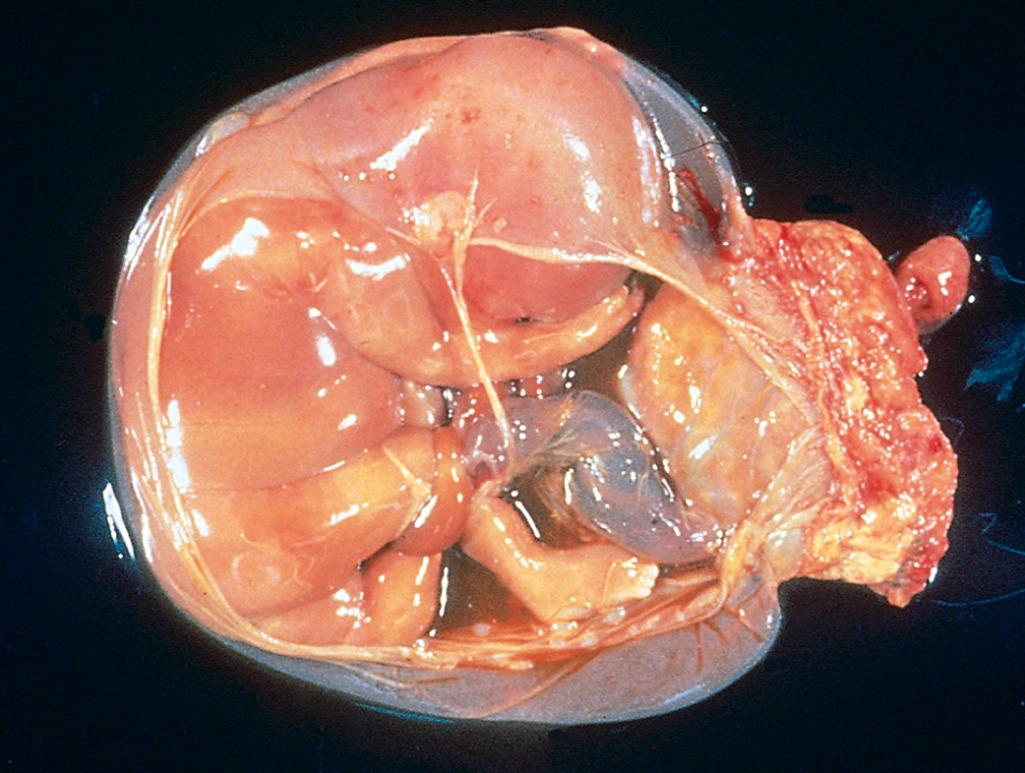
Deformations, like disruptions, represent an extrinsic disturbance of development rather than an intrinsic error of morphogenesis. Deformations are common problems, affecting approximately 2% of newborn infants to varying degrees. Fundamental to the pathogenesis of deformations is localized or generalized compression of the growing fetus by abnormal biomechanical forces, leading eventually to a variety of structural abnormalities. The most common underlying factor responsible for deformations is uterine constraint. Between 35 and 38 weeks of gestation, rapid increase in the size of the fetus outpaces the growth of the uterus, and the relative amount of amniotic fluid (which normally acts as a cushion) decreases. Thus, even the normal fetus is subjected to some degree of uterine constraint. Several factors increase the likelihood of excessive compression of the fetus resulting in deformations. Maternal factors include first pregnancy, small uterus, malformed (e.g., bicornuate) uterus, and leiomyomas. Fetal or placental factors include oligohydramnios, multiple fetuses, and abnormal fetal presentation. For example, clubfeet can occur as a component of Potter sequence, described later.
A sequence is a cascade of anomalies triggered by one initiating aberration . Approximately one-half the time, congenital anomalies occur singly; in the remaining cases, multiple congenital anomalies are recognized. In some instances, the constellation of anomalies may be explained by a single localized aberration in organogenesis (malformation, disruption, or deformation) that sets into motion secondary effects in other organs. A good example is the oligohydramnios (or Potter ) sequence ( Fig. 10.3 ). Oligohydramnios (decreased amniotic fluid) may be caused by a variety of unrelated maternal, placental, or fetal abnormalities. The most common cause of oligohydramnios is chronic leakage of amniotic fluid due to rupture of fetal membranes. Other causes include renal agenesis and urinary tract obstruction in the fetus (because fetal urine is a major constituent of amniotic fluid), and uteroplacental insufficiency resulting from maternal hypertension or severe preeclampsia. The fetal compression associated with significant oligohydramnios, in turn, results in a classic phenotype in the newborn infant, including flattened facies, positional abnormalities of the hands, and clubfeet ( Fig. 10.4 ). The hips may be dislocated. Growth of the chest wall and the contained lungs is also compromised so that the lungs are frequently hypoplastic, and may cause fetal demise. Nodules in the amnion (amnion nodosum) are frequently present.
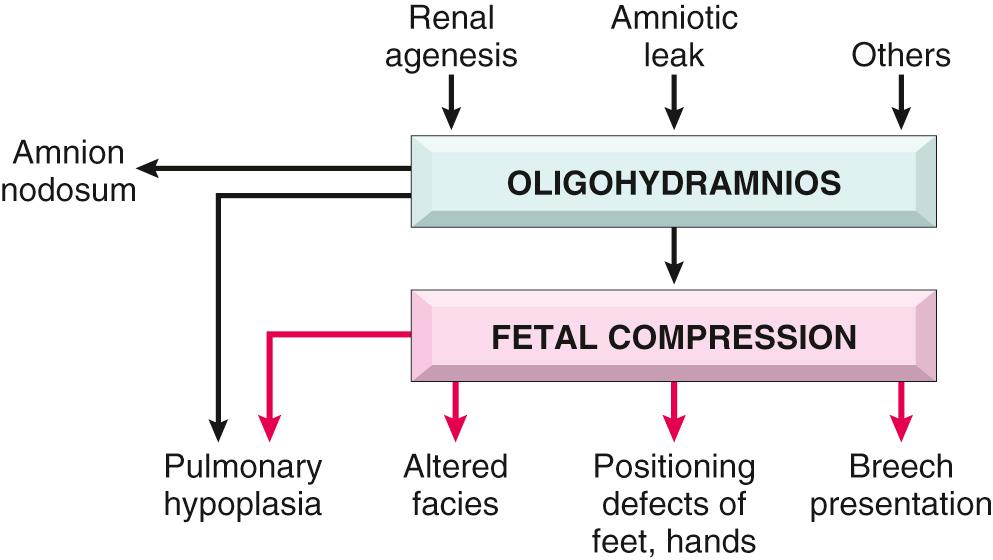
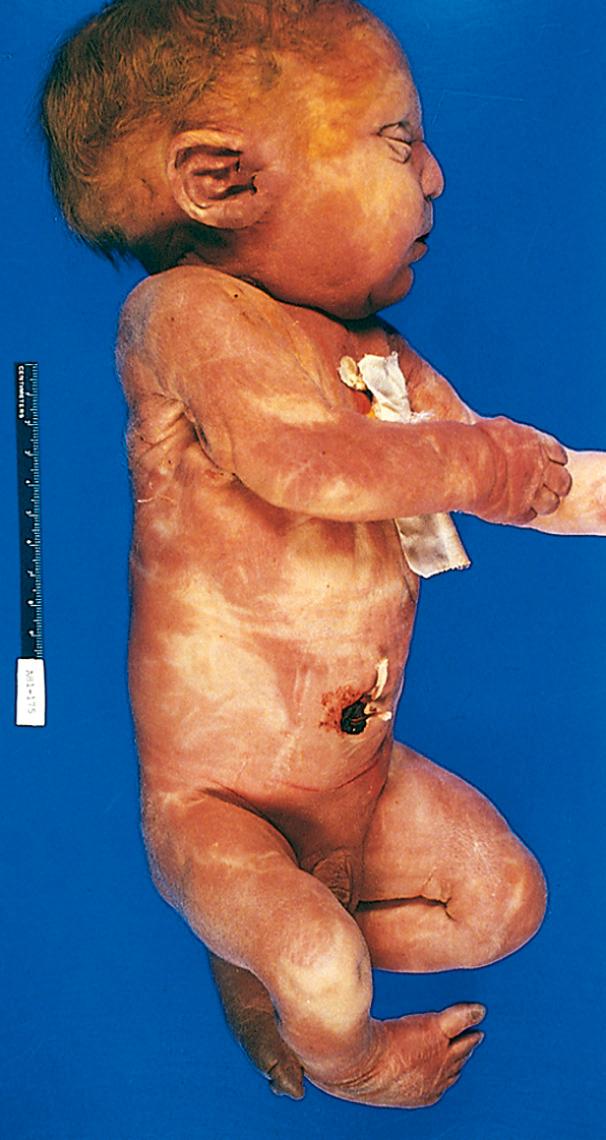
A malformation syndrome is a constellation of congenital anomalies , believed to be pathologically related, that, in contrast to a sequence, cannot be explained on the basis of a single, localized, initiating defect. Syndromes are most often caused by a single etiologic agent, such as a viral infection or specific chromosomal abnormality, which simultaneously affects several tissues.
In addition to the aforementioned general definitions, a few organ-specific terms should be defined. Agenesis refers to the complete absence of an organ and its associated primordium. A closely related term, aplasia, also refers to the absence of an organ but one that occurs due to failure of growth of the existing primordium. Atresia describes the absence of an opening, usually of a hollow visceral organ, such as the trachea or intestine. Hypoplasia refers to incomplete development or decreased size of an organ with decreased numbers of cells, whereas hyperplasia refers to the converse, that is, the enlargement of an organ due to increased numbers of cells. An abnormality in an organ or a tissue as a result of an increase or a decrease in the size (rather than the number) of individual cells defines hypertrophy or hypotrophy, respectively . Finally, dysplasia in the context of malformations (versus neoplasia ) describes an abnormal organization of cells.
Although we are learning a great deal about the molecular bases of some congenital anomalies, the exact cause remains unknown in 40% to 60% of cases . The era of molecular medicine promises to bring additional insights into the mechanisms by which malformations occur. The common known causes of congenital anomalies can be grouped into three major categories: genetic, environmental, and multifactorial ( Table 10.1 ).
| Cause | Frequency (%) |
|---|---|
| Genetic | |
|
|
|
|
| Environmental | |
|
|
|
|
|
|
|
|
|
|
|
|
|
|
|
|
|
|
|
|
|
|
|
|
|
|
|
|
|
|
|
|
|
|
|
|
|
|
|
|
| Multifactorial |
|
| Unknown |
|
Genetic causes of malformations include all of the previously discussed mechanisms of genetic disease ( Chapter 5 ). Virtually all chromosomal syndromes are associated with congenital malformations. Examples include Down syndrome and other trisomies, Turner syndrome, and Klinefelter syndrome. Most chromosomal disorders arise during gametogenesis and hence are not familial. Single-gene mutations, characterized by Mendelian inheritance, may underlie some major malformations. For example, holoprosencephaly is the most common developmental defect of the forebrain and midface in humans; the Hedgehog signaling pathway plays a critical role in the morphogenesis of these structures, and loss-of-function mutations of individual components within this pathway are reported in families with a history of recurrent holoprosencephaly.
Environmental influences, such as viral infections, drugs, and maternal irradiation, may cause fetal anomalies. Among the viral infections listed in Table 10.1 , rubella was a major scourge of the nineteenth and early twentieth centuries. Fortunately, maternal rubella and the resultant rubella embryopathy have been virtually eliminated in high income countries as a result of maternal rubella vaccination. A variety of drugs and chemicals have been suspected to be teratogenic, but perhaps less than 1% of congenital malformations are caused by these agents. The list includes thalidomide, alcohol, anticonvulsants, warfarin (oral anticoagulant), and 13- cis -retinoic acid, which is used in the treatment of severe acne. For example, thalidomide , once used as a tranquilizer in Europe, causes an extremely high incidence (50% to 80%) of limb malformations. Alcohol, when consumed even in modest amounts during pregnancy, is an important environmental teratogen. Affected infants show prenatal and postnatal growth restriction, facial anomalies (microcephaly, short palpebral fissures, maxillary hypoplasia), and psychomotor disturbances. These in combination are labeled the fetal alcohol syndrome (also discussed in Chapter 9 ). Although cigarette smoke–derived nicotine has not been convincingly demonstrated to be a teratogen, there is a high incidence of spontaneous abortion, premature labor, and placental abnormalities in pregnant women who smoke, babies born to mothers who smoke often have a low birth weight and may be prone to sudden infant death syndrome (discussed later). In light of these findings, it is best to avoid nicotine exposure altogether during pregnancy. Among maternal conditions listed in Table 10.1 , diabetes mellitus is a common entity, and despite advances in antenatal obstetric monitoring and glucose control, the incidence of major malformations in infants of diabetic mothers stands between 6% and 10% in most series. Maternal hyperglycemia-induced fetal hyperinsulinemia results in fetal macrosomia (organomegaly and increased body fat and muscle mass); cardiac anomalies, neural tube defects, and other central nervous system (CNS) malformations are some of the major anomalies seen in diabetic embryopathy.
Multifactorial inheritance, which implies the interaction of environmental influences with two or more genes of small effect, is the most common genetic etiology of congenital malformations. Examples include relatively common malformations such as cleft lip, cleft palate, and neural tube defects. The dramatic reduction in incidence of neural tube defects by periconceptional intake of folic acid is one case where understanding the environmental stimuli has prevented development of multifactorial malformations even though contributing genes have not been eliminated.
The pathogenesis of congenital anomalies is complex and still poorly understood, but two general principles of developmental pathology are relevant regardless of the etiologic agent.
The timing of the prenatal teratogenic insult has an important impact on the occurrence and the type of anomaly produced ( Fig. 10.5 ). The intrauterine development of humans can be divided into two phases: (1) the early embryonic period occupying the first 9 weeks of pregnancy and (2) the fetal period terminating at birth.
In the early embryonic period (first 3 weeks after fertilization), an injurious agent damages either enough cells to cause death and abortion or only a few cells, presumably allowing the embryo to recover without developing defects. Between the third and the ninth weeks, the embryo is extremely susceptible to teratogenesis; peak sensitivity occurs between the fourth and the fifth weeks. During this period, organs are being crafted out of the germ cell layers.
The fetal period that follows organogenesis is marked chiefly by further growth and maturation of the organs, with greatly reduced susceptibility to teratogenic agents. Instead, the fetus is susceptible to growth restriction or injury to already formed organs. Thus a given agent may produce different anomalies if exposure occurs at different times of gestation.
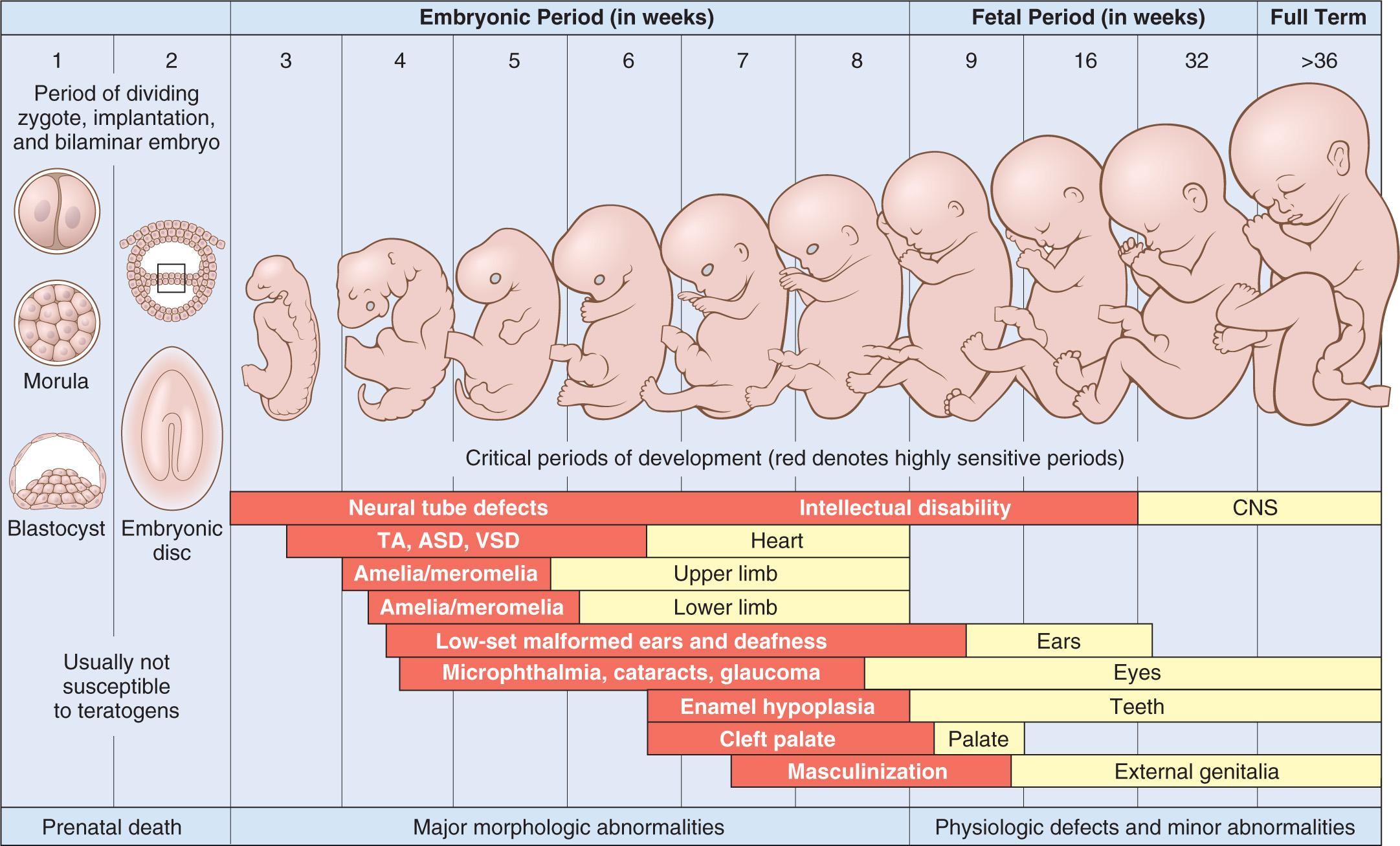
The interplay between environmental teratogens and intrinsic genetic defects is exemplified by the fact that features of dysmorphogenesis caused by environmental insults can often be recapitulated by genetic defects in the pathways targeted by these teratogens . This is illustrated by the following representative examples.
Cyclopamine is a plant teratogen contained in the corn lily; pregnant sheep who feed on this plant give birth to lambs with severe craniofacial abnormalities including holoprosencephaly and “cyclopia” (single fused eye, hence the origin of the moniker cyclopamine). This compound is an inhibitor of Hedgehog signaling in the embryo, and, as stated earlier, mutations of Hedgehog genes are present in subsets of patients with holoprosencephaly.
Valproic acid is an antiepileptic and a recognized teratogen during pregnancy. Valproic acid disrupts expression of a family of highly conserved developmentally critical transcription factors known as homeobox (HOX) proteins. In vertebrates, HOX proteins have been implicated in the patterning of limbs, vertebrae, and craniofacial structures. Not surprisingly, mutations in the HOX family of genes are responsible for congenital anomalies that mimic features observed in valproic acid embryopathy.
The vitamin A (retinol) derivative all-trans-retinoic acid is essential for normal development and differentiation, and its absence during embryogenesis results in a constellation of malformations affecting multiple organ systems, including the eyes, genitourinary system, cardiovascular system, diaphragm, and lungs (see Chapter 9 for effects of vitamin A deficiency in the postnatal period). Conversely, excessive exposure to retinoic acid is also teratogenic. Infants born to mothers treated with retinoic acid for severe acne have a predictable phenotype (retinoic acid embryopathy) including CNS, cardiac, and craniofacial defects, such as cleft lip and cleft palate. The latter may stem from retinoic acid–mediated deregulation of components of the transforming growth factor-β (TGF-β) signaling pathway, which is involved in palatogenesis. Mice with knockout of the Tgfb3 gene uniformly develop cleft palate, once again illustrating the functional relationship between teratogenic exposure and signaling pathways in the causation of congenital anomalies.
Prematurity, defined by a gestational age less than 37 weeks, is the second most common cause of neonatal mortality, behind only congenital anomalies. The Centers for Disease Control and Prevention (CDC; cdc.gov/reproductivehealth ) report that in 2016, preterm birth affected about 1 in 10 infants born in the United States. Preterm birth rates decreased from 2007 to 2014 due, in part, to declines in the number of births to teens and young mothers; however, the rate among African-American women (14%) remains greater than that in white women (9%). The major risk factors for prematurity include the following:
Preterm premature rupture of membranes (PPROM): PPROM complicates about 3% of all pregnancies and is responsible for as many as one-third of all preterm deliveries. Rupture of membranes (ROM) before the onset of labor can be spontaneous or induced. PPROM refers to spontaneous ROM occurring before 37 weeks of gestation (hence the annotation “preterm”). In contrast, PROM refers to spontaneous ROM occurring after 37 weeks of gestation. This distinction is important because after 37 weeks the associated risk to the fetus is considerably decreased. Several clinical risk factors have been identified for PPROM, including a prior history of preterm delivery, preterm labor and/or vaginal bleeding during the current pregnancy, maternal smoking, low socioeconomic status, and poor maternal nutrition. The fetal and maternal outcome after PPROM depends on the gestational age of the fetus (second-trimester PPROM has a dismal prognosis) and the effective prophylaxis of infections in the exposed amniotic cavity.
Intrauterine infection: This is a major cause of preterm labor with and without intact membranes. Intrauterine infection is present in approximately 25% of all preterm births, and the earlier the gestational age at delivery, the higher the frequency of intra-amniotic infection. The histologic correlates of intrauterine infection are inflammation of the placental membranes (chorioamnionitis) and inflammation of the fetal umbilical cord (funisitis). The most common microorganisms implicated in intrauterine infections leading to preterm labor are Ureaplasma urealyticum, Mycoplasma hominis, Gardnerella vaginalis (the dominant organism found in “bacterial vaginosis,” a polymicrobial infection), Trichomonas, gonorrhea, and Chlamydia. In low income countries, malaria and HIV are significant contributors to the burden of preterm labor and prematurity. Recent studies have begun to elucidate the molecular mechanisms of inflammation-induced preterm labor. Endogenous Toll-like receptors (TLRs), which bind bacterial components as natural ligands ( Chapter 6 ), have emerged as key players in this process. It is postulated that signals produced by TLR engagement deregulate prostaglandin expression, which, in turn, induces uterine smooth muscle contractions.
Uterine, cervical, and placental structural abnormalities: Uterine distortion (e.g., uterine fibroids), compromised structural support of the cervix (“cervical incompetence”), placenta previa, and abruptio placentae ( Chapter 22 ) are associated with an increased risk of prematurity.
Multiple gestation (twin pregnancy)
The hazards of prematurity are manifold for the newborn and may give rise to one or more of the following:
Neonatal respiratory distress syndrome, also known as hyaline membrane disease
Necrotizing enterocolitis (NEC)
Sepsis
Intraventricular and germinal matrix hemorrhage
Although preterm infants have low birth weights, it is usually appropriate once adjusted for their gestational age. In contrast, as many as one-third of infants who weigh less than 2500 g are born at term and are therefore undergrown rather than immature. These small-for-gestational-age (SGA) infants suffer from fetal growth restriction (FGR),which may result from maternal, fetal, or placental abnormalities, although in many cases the specific cause is unknown.
By far the most common factors associated with SGA infants are maternal conditions that result in decreased placental blood flow. Vascular diseases such as preeclampsia (toxemia of pregnancy) and chronic hypertension are often the underlying cause. The list of other maternal conditions associated with SGA infants is long, but some of the avoidable factors worth mentioning are maternal narcotic abuse, alcohol intake, and heavy cigarette smoking . Drugs causing FGR include both classic teratogens, such as chemotherapeutic agents, and some commonly administered therapeutic agents, such as phenytoin (Dilantin). Maternal malnutrition (in particular, prolonged hypoglycemia) may also affect fetal growth.
Fetal influences are those that intrinsically reduce growth potential of the fetus despite an adequate supply of nutrients from the mother. Prominent among such fetal conditions are chromosomal disorders, congenital anomalies, and congenital infections . Chromosomal abnormalities may be detected in up to 17% of fetuses sampled for FGR and in up to 66% of fetuses with documented ultrasonographic malformations. Among the first group, the abnormalities include triploidy (7%), trisomy 18 (6%), trisomy 21 (1%), trisomy 13 (1%), and a variety of deletions and translocations (2%). Fetal infection should be considered in all infants with FGR. Those most commonly responsible for FGR are the TORCH group of infections ( t oxoplasmosis, o ther viruses and bacteria such as syphilis, r ubella, c ytomegalovirus, and h erpesvirus). Infants who are SGA because of fetal factors usually have symmetric growth restriction (also referred to as proportionate FGR), meaning that all organ systems are similarly affected.
During the third trimester of pregnancy, vigorous fetal growth places particularly heavy demands on the uteroplacental blood supply. Therefore, the adequacy of placental growth in the preceding midtrimester is extremely important, and uteroplacental insufficiency is an important cause of growth restriction. This insufficiency may result from umbilical-placental vascular anomalies (such as single umbilical artery and abnormal cord insertion), placental abruption, placenta previa, placental thrombosis and infarction, chronic villitis of unknown etiology, placental infection, or multiple gestations ( Chapter 22 ). In some cases the placenta (and the baby) may be small without any detectable underlying cause. Placental causes of FGR tend to result in asymmetric (or disproportionate) growth restriction of the fetus with relative sparing of the brain. Physiologically, this general type of FGR is viewed as a down-regulation of growth in the latter half of gestation because of limited availability of nutrients or oxygen.
The SGA infant faces a difficult course, not only during the struggle for survival in the perinatal period, but also in childhood and adult life. Depending on the underlying cause of FGR and, to a lesser extent, the degree of prematurity, there is a significant risk of morbidity in the form of a major handicap such as cerebral dysfunction, learning disability, or hearing and visual impairment.
There are many causes of respiratory distress in the newborn. The most common cause is neonatal respiratory distress syndrome (RDS), also known as hyaline membrane disease because of the deposition of a layer of hyaline proteinaceous material in the peripheral airspaces of infants who succumb to this condition. Others include excessive sedation of the mother, fetal head injury during delivery, aspiration of blood or amniotic fluid, and intrauterine hypoxia brought about by coiling of the umbilical cord about the neck. The incidence of RDS increases with decreasing gestational age, being 1% at 37 weeks, 10.5% at 34 weeks, and 93% in extremely preterm infants (28 weeks or below).
The fundamental defect in RDS is pulmonary immaturity and deficiency of surfactant. As described in Chapter 15 , surfactant consists predominantly of dipalmitoyl phosphatidylcholine (lecithin), smaller amounts of phosphatidylglycerol, and two groups of surfactant-associated proteins. The first group is composed of hydrophilic glycoproteins SP-A and SP-D, which play a role in pulmonary host defense (innate immunity). The second group consists of hydrophobic surfactant proteins SP-B and SP-C, which, in concert with the surfactant lipids, are involved in the reduction of surface tension at the air-liquid barrier in the alveoli of the lung. With reduced surface tension in the alveoli, less pressure is required to keep them patent and hence aerated. The importance of surfactant proteins in normal lung function can be gauged by the occurrence of severe respiratory failure in neonates with congenital deficiency of surfactant caused by mutations in the SFTPB or SFTPC genes.
Surfactant production by type II alveolar cells is accelerated after the 35th week of gestation in the fetus. At birth, the first breath of life requires high inspiratory pressures to expand the lungs. With normal levels of surfactant, the lungs retain up to 40% of the residual air volume after the first breath; thus, subsequent breaths require far lower inspiratory pressures. With a deficiency of surfactant, the lungs collapse with each successive breath, so infants must work as hard with each successive breath as they did with the first. The problem of stiff atelectatic lungs is compounded by the soft thoracic wall that is pulled in as the diaphragm descends. Progressive atelectasis and reduced lung compliance then lead to a chain of events as depicted in Fig. 10.6 , resulting in protein-rich, fibrin-rich exudation into the alveolar spaces with the formation of hyaline membranes. The fibrin-hyaline membranes are barriers to gas exchange, leading to carbon dioxide retention and hypoxemia. The hypoxemia itself further impairs surfactant synthesis, and a vicious cycle ensues.
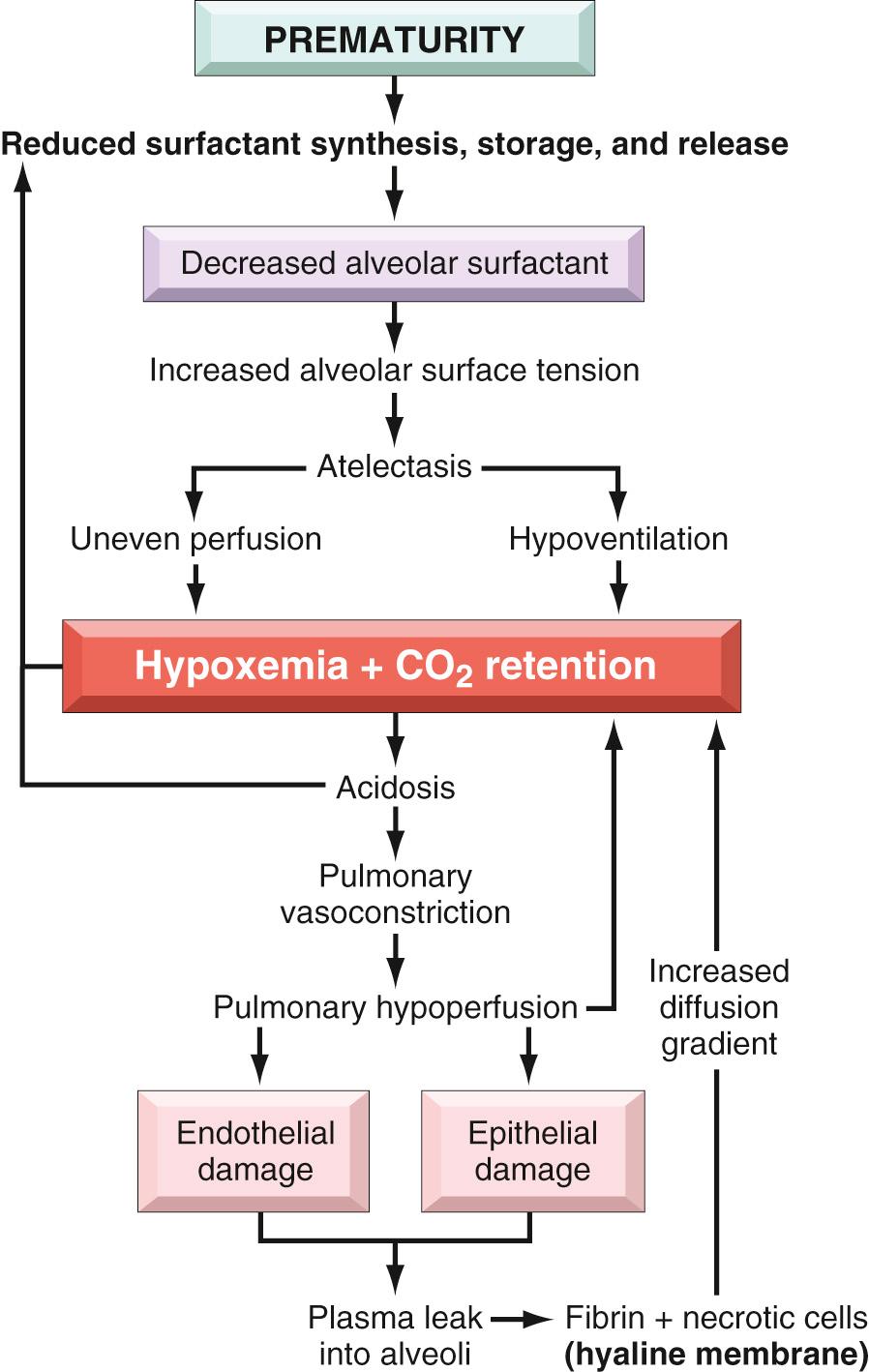
Surfactant synthesis is modulated by a variety of hormones and growth factors, including cortisol, insulin, prolactin, thyroxine, and TGF-β. The role of glucocorticoids is particularly important . Conditions associated with intrauterine stress and FGR that increase corticosteroid release lower the risk of developing RDS. Surfactant synthesis can be suppressed by the compensatory high blood levels of insulin in infants of diabetic mothers, which counteracts the effects of steroids. This may explain, in part, why infants of diabetic mothers have a higher risk of developing RDS. Labor is known to increase surfactant synthesis; hence, cesarean delivery before the onset of labor may increase the risk of RDS.
The lungs are distinctive on gross examination. Though of normal size, they are solid, airless, and reddish purple, similar to the color of the liver, and they usually sink in water, indicating the relative absence of entrapped air. Microscopically, alveoli are poorly developed, and those that are present are collapsed ( Fig. 10.7 ). When the infant dies early in the course of the disease, necrotic cellular debris can be seen in the terminal bronchioles and alveolar ducts. The necrotic material becomes incorporated within eosinophilic hyaline membranes lining the respiratory bronchioles, alveolar ducts, and alveoli. The membranes are largely made up of fibrin admixed with cell debris derived chiefly from necrotic type II pneumocytes. The sequence of events that leads to the formation of hyaline membranes is depicted in Fig. 10.6 . There is a remarkable paucity of neutrophilic inflammatory reaction associated with these membranes. The lesions of hyaline membrane disease are never seen in stillborn infants.

In infants who survive more than 48 hours, progressive reparative changes occur in the lungs. The alveolar epithelium proliferates under the surface of the membrane, which may detach into the airspace where it undergoes partial digestion or phagocytosis by macrophages. If it does not detach, fibroblasts grow into the membrane, and it becomes incorporated into the alveolar wall.
The infant is almost always preterm but has weight appropriate for gestational age, and there are strong but not invariable associations with male gender, maternal diabetes, and cesarean delivery . Resuscitation may be necessary at birth, but usually within a few minutes rhythmic breathing and normal color are reestablished. Soon afterward, often within 30 minutes, breathing becomes more difficult, and within a few hours cyanosis becomes evident in the untreated infant. Fine rales can then be heard over both lung fields. A chest radiograph at this time usually reveals uniform minute reticulogranular densities, producing a so-called ground-glass picture. In the full-blown condition, the respiratory distress persists, cyanosis increases, and even the administration of 80% oxygen by a variety of ventilatory methods fails to improve the situation. If therapy staves off death for the first 3 or 4 days, however, the infant has an excellent chance of recovery.
Currently, the actual clinical course and prognosis for neonatal RDS vary, depending on the maturity and birth weight of the infant and the promptness of institution of therapy. A major thrust in the control of RDS focuses on prevention, either by delaying labor until the fetal lung reaches maturity or by inducing maturation of the lung in the at-risk fetus by use of antenatal steroids. Critical to these objectives is the ability to assess fetal lung maturity accurately. Because pulmonary secretions are discharged into the amniotic fluid, analysis of amniotic fluid phospholipids provides a good estimate of the level of surfactant in the alveolar lining. Prophylactic administration of exogenous surfactant at birth to extremely premature infants (gestational age <28 weeks) has been shown to be very beneficial. Together with newer assisted ventilation techniques, this has resulted in dramatic improvement in pulmonary function, symptom resolution, a shortened course, and markedly reduced mortality. In uncomplicated cases, recovery begins to occur within 3 or 4 days.
Complications of RDS, retrolental fibroplasia (also called retinopathy of prematurity) in the eyes, and bronchopulmonary dysplasia are now less frequent and less severe when they do occur.
Retinopathy of prematurity has a two-phase pathogenesis. During the hyperoxic phase of RDS therapy (phase I), expression of the proangiogenic vascular endothelial growth factor (VEGF) is markedly decreased, causing endothelial cell apoptosis; VEGF levels rebound after return to relatively hypoxic room air ventilation (phase II), inducing retinal vessel proliferation (neovascularization) characteristic of the lesions in the retina ( Chapter 29 ).
Bronchopulmonary dysplasia is characterized by striking decrease in alveolar septation (manifested as large, simplified alveolar structures) and a dysmorphic capillary configuration . Thus, the current view is that bronchopulmonary dysplasia is caused by a potentially reversible impairment in the development of alveolar septation at the so-called “saccular” stage. Multiple factors—hyperoxemia, hyperventilation, prematurity, inflammatory cytokines, and vascular maldevelopment—contribute to bronchopulmonary dysplasia and probably act additively or synergistically to promote injury. The levels of a variety of proinflammatory cytokines (TNF, interleukin-1β [IL-1β], IL-6, and IL-8) are increased in the alveoli of infants who develop bronchopulmonary dysplasia, suggesting a role for these cytokines in arresting pulmonary development. Treatment with mesenchymal stem cells has potential but remains experimental. They act by secreting soluble factors that suppress inflammation and favor repair of the air spaces.
Infants who recover from RDS are also at increased risk for developing a variety of other complications associated with preterm birth; most important among these are patent ductus arteriosus, intraventricular hemorrhage, and necrotizing enterocolitis.
Necrotizing enterocolitis (NEC) is most common in premature infants, with the incidence of the disease being inversely proportional to the gestational age. It occurs in approximately 1 in 10 very-low-birth-weight infants (<1500 g). Approximately 2500 cases occur annually in the United States.
The pathogenesis of NEC is uncertain but multifactorial. In addition to prematurity, most cases are associated with enteral feeding, suggesting that some postnatal insult (such as introduction of bacteria) sets in motion a cascade of events culminating in tissue destruction. Although infectious agents may play a role in the pathogenesis of NEC, no single bacterial pathogen has been linked to the disease. Perhaps alteration in the microbiome on enteral feeding plays a role. A large number of inflammatory mediators have been associated with NEC. One particular mediator, platelet activating factor (PAF), has been implicated in increasing mucosal permeability by promoting enterocyte apoptosis and compromising intercellular tight junctions, thus adding “fuel to the fire.” Stool and serum samples of infants with NEC demonstrate higher PAF levels than age-matched controls. Ultimately, breakdown of mucosal barrier functions permits transluminal migration of gut bacteria, leading to a vicious cycle of inflammation, mucosal necrosis, and further bacterial entry, eventually culminating in sepsis and shock ( Chapter 4 ).
The clinical course is fairly typical, with the onset of bloody stools, abdominal distention, and development of circulatory collapse. Abdominal radiographs often demonstrate gas within the intestinal wall (pneumatosis intestinalis). When detected early, NEC often can be managed conservatively, but many cases (20% to 60%) require resection of the necrotic segments of bowel. NEC is associated with high perinatal mortality; those who survive often develop post-NEC strictures from fibrosis caused by the healing process. Probiotic therapies are being evaluated for prevention of NEC.
NEC typically involves the terminal ileum, cecum, and right colon, although any part of the small or large intestine may be involved. The involved segment is distended, friable, and congested, or it can be frankly gangrenous; intestinal perforation with accompanying peritonitis may occur. Microscopically, mucosal or transmural coagulative necrosis, ulceration, bacterial colonization, and submucosal gas bubbles may be seen ( Fig. 10.8 ). Reparative changes, such as the formation of granulation tissue and fibrosis, may begin shortly after the acute episode.
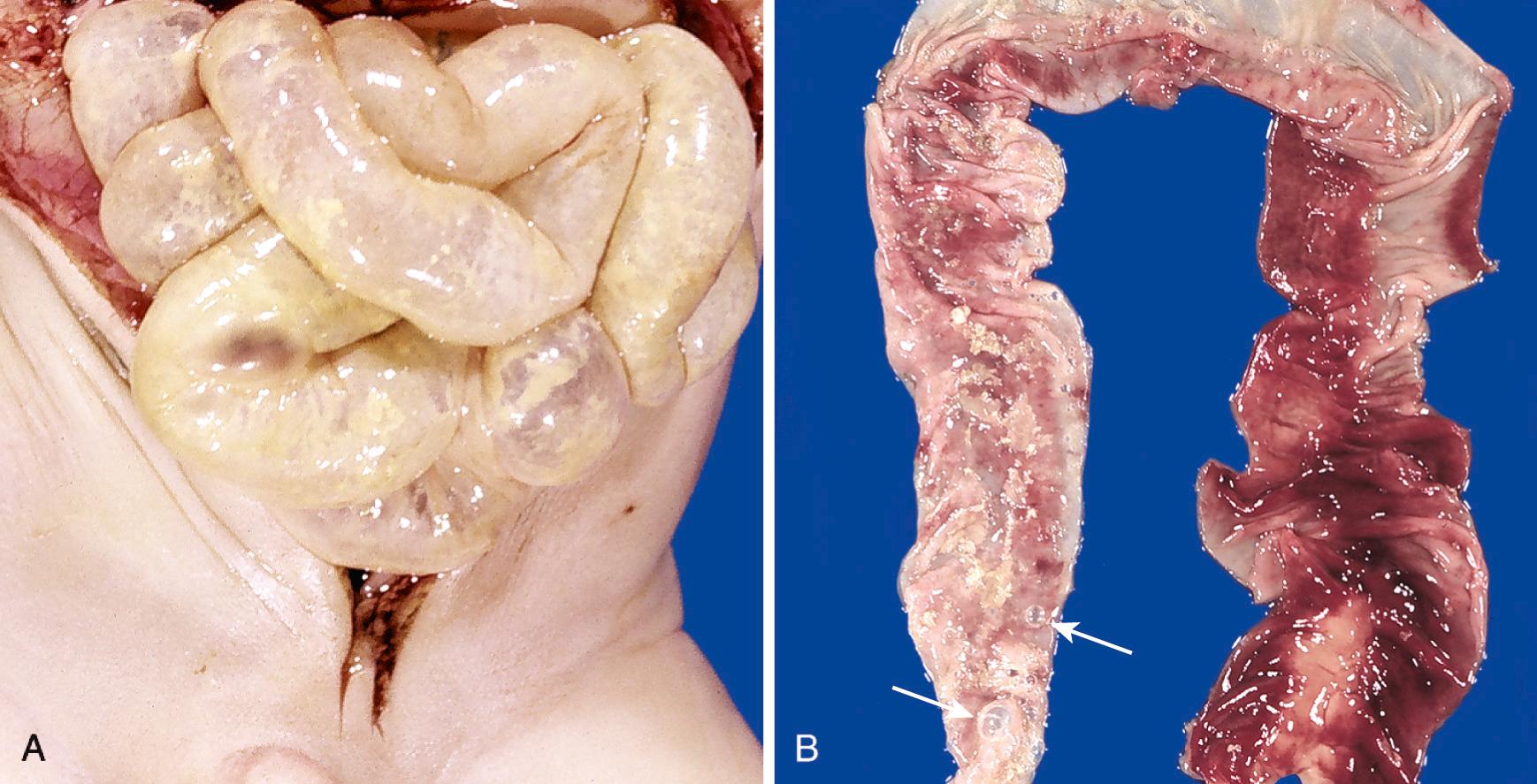
In general, fetal and perinatal infections are acquired through one of two primary routes—transcervically (also referred to as ascending) or transplacentally (hematologic). Occasionally, infections occur by a combination of the two routes in that an ascending microorganism infects the endometrium and then invades the fetal bloodstream via the chorionic villi.
Most bacterial and a few viral (e.g., herpes simplex II) infections are acquired by the cervicovaginal route. Such infections may be acquired in utero or around the time of birth. In general, the fetus acquires the infection either by inhaling infected amniotic fluid into the lungs shortly before birth or by passing through an infected birth canal during delivery. As stated earlier, preterm birth is a common and unfortunate consequence of infection. Preterm birth due to infection may be related either to damage and rupture of the amniotic sac as a direct consequence of the inflammation, or to the induction of labor by prostaglandins released from infiltrating neutrophils. Inflammation of the placental membranes and cord are usually seen, but the presence or absence and severity of chorioamnionitis do not necessarily correlate with the severity of the fetal infection. In the fetus infected by inhalation of amniotic fluid, pneumonia, sepsis, and meningitis are the most common sequelae.
Most parasitic (e.g., Toxoplasma, malaria) and viral infections and a few bacterial infections (i.e., Listeria , Treponema ) gain access to the fetal bloodstream transplacentally via the chorionic villi. This hematogenous transmission may occur at any time during gestation or occasionally, as may be the case with hepatitis B and HIV, at the time of delivery via maternal-to-fetal transfusion. The clinical manifestations of these infections are highly variable, depending largely on the gestational timing and microorganism involved.
Parvovirus B19, which causes erythema infectiosum or “fifth disease of childhood” in immunocompetent older children, can infect 1% to 5% of seronegative (nonimmune) pregnant women, and the vast majority have a normal pregnancy outcome. Adverse pregnancy outcomes in a minority of intrauterine infections include spontaneous abortion (particularly in the second trimester), stillbirth, hydrops fetalis (see later), and congenital anemia. Parvovirus B19 has a particular tropism for erythroid cells, and diagnostic viral inclusions can be seen in early erythroid progenitors in infected infants ( Fig. 10.9 ).
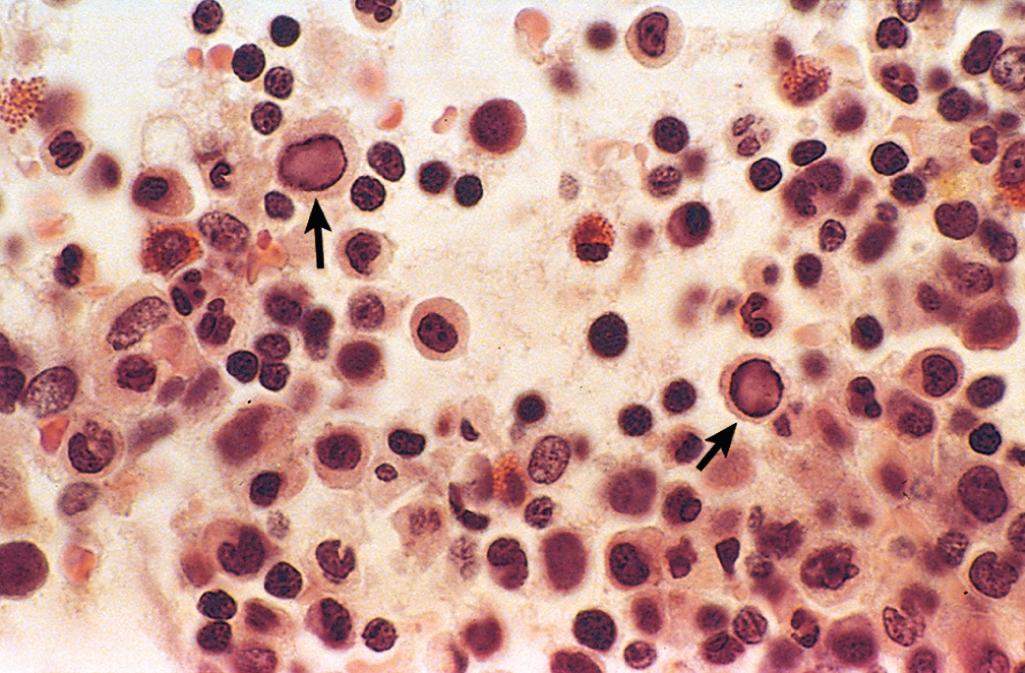
The TORCH group of infections (see earlier) are grouped together because they may evoke similar clinical and pathologic manifestations, including fever, encephalitis, chorioretinitis, hepatosplenomegaly, pneumonitis, myocarditis, hemolytic anemia, and vesicular or hemorrhagic skin lesions. Such infections occurring early in gestation may also cause chronic sequelae in the child, including growth retardation and intellectual disability, cataracts, congenital cardiac anomalies, and bone defects.
Become a Clinical Tree membership for Full access and enjoy Unlimited articles
If you are a member. Log in here